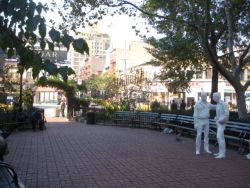Christopher Park
General Philip Henry Sheridan
This expressive bronze portrait of General Philip Henry Sheridan (1831-1888), created by Joseph Pollia (1893-1954), was unveiled in Christopher Park in 1936. The sculpture honors the distinguished Civil War cavalry commander for whom the surrounding square was named in 1896. It is one of nine statues of Civil War generals in New York City parks.
Sheridan was born on March 6, 1831, and enrolled at the United States Military Academy at West Point in 1848. He graduated in 1853, and was appointed brevet 2nd lieutenant in the 1st Infantry. After rising to the rank of captain in 1861, Sheridan was appointed chief quartermaster and commissary of the army in southwestern Missouri. After difficult, but effective, quartermaster work in the Mississippi campaign of 1862, Sheridan was named colonel of the 2nd Michigan Cavalry.
The success of Sheridan’s 1862-63 campaign led General Grant to place him in charge of the cavalry of the Army of the Potomac, and then the Army of the Shendandoah. Sheridan’s most storied victory of this period was the battle of Cedar Creek in the Shenandoah Valley. His heroic acts on October 19, 1864 were immortalized in Thomas Buchanan Read’s poem, Sheridan’s Ride.
In 1865, Sheridan’s bold military tactics achieved victory over General Pickett at Five Forks, Virginia, and at the war’s end, Sheridan was promoted to Major General and assigned to the southwest to counter Maximilian’s French troops in Mexico. In 1867, Sheridan was made a military governor of the district encompassing Louisiana and Texas, and then the Department of Missouri. Promoted by Grant in 1869 to lieutenant general, Sheridan then succeeded General Sherman in 1884 as commander-in-chief of the United States Army. In 1888, Sheridan was promoted to full general and he published his memoirs. He died that same year of a heart attack at age 57. He is remembered as a brilliant military tactician and an assertive commander in battle.
In 1924, the General Sheridan Memorial Committee was organized by John B. Trainer, former secretary of the Armory Board of New York City. The committee raised $6,000 through public subscription to erect the statue in Christopher Park. The statue was dedicated in elaborate ceremonies on October 19, 1936, coinciding with the 72nd anniversary of the Cedar Creek victory. A time capsule, including the names of all contributors, was sealed at the base of the statue. Italian-born sculptor Joseph Pollia, who created the statue of Sheridan, received numerous public commissions, and in 1926, also sculpted the World War I Doughboy figure known as My Buddy or the Richmond Hill War Memorial, which stands in Forest Park, Queens.
Although many images of the general show him astride his horse Rienzi, Sheridan’s larger-than-life statue depicts him standing in full Union Army regalia, booted and spurred, with a sword swinging at his side. It is set within a fenced and landscaped enclosure, atop a granite base that includes an inscription on its north face attributed to General Ulysses S. Grant: “He belongs to the first rank of soldiers, not only of our country, but of the world.”
In 2000, the City Parks Foundation Monuments Conservation Program conserved the sculpture. Funding for the project came through numerous contributions in a campaign spearheaded by Robert W. Lord, a descendant of four Civil War soldiers for the Union. Additional matching funds from the American Express Company, the Florence Gould Foundation, and the Samuel H. Kress Foundation made the project possible. On October 19, 2000, the statue was rededicated in a ceremony that recalled the original dedication, and a time capsule of new contributors was buried near the base of the monument.
Check out your park's Vital Signs
Clean & Safe
Green & Resilient
Empowered & Engaged Users
Share your feedback or learn more about how this park is part of a
Vital Park System

